A Siberian Cat is an ancient breed of domestic cat that originated in Russia. It has long, thick fur and a variety of colors and patterns. These cats are highly intelligent, independent, loyal, and affectionate companions. They are loving cats that form lifelong bonds with their owners and can be very vocal when expressing themselves. The average life span for a Siberian Cat is 12-15 years, but some may live longer than that! This breed also requires frequent grooming due to its thick coat, which sheds more than most breeds. Let’s go over 40 beautiful types of Siberian cats.
40 Types of Siberian Cats
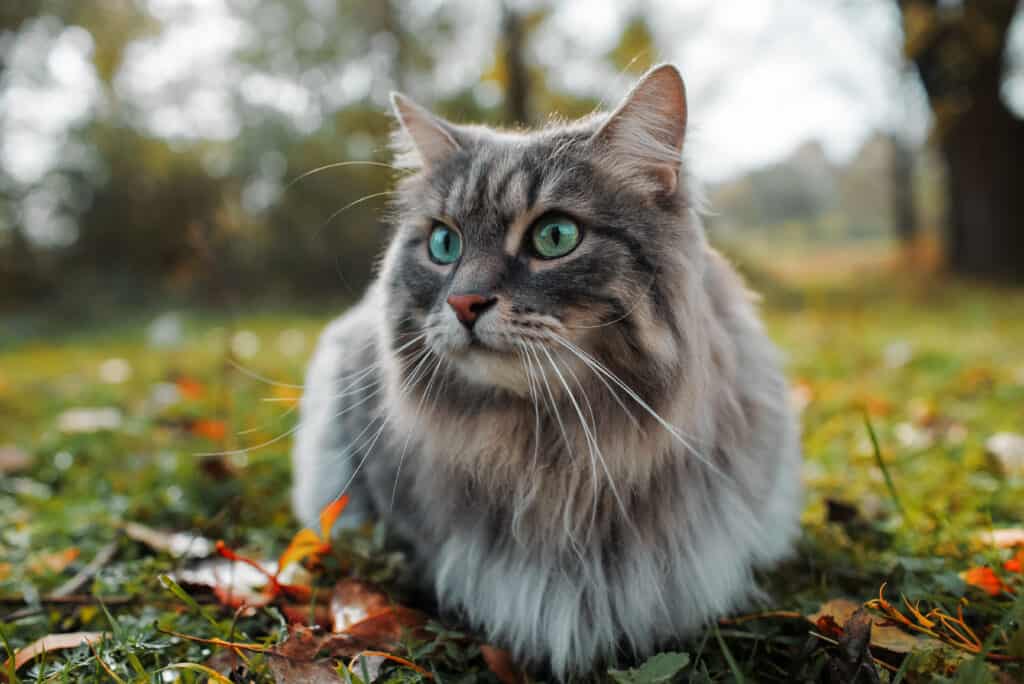
Siberians come in many colors and patterns.
©Sergio Photone/Shutterstock.com
The Siberian cat is a medium to long-haired breed with a triple coat. The fur on the shoulders and lower chest should be thick and slightly shorter in length than the rest. There should also be a considerable full ruff around the head. The texture of the fur differs according to the color, ranging from coarse to soft, and there is a dense undercoat in fully-grown cats, which is thicker in cold weather. Most colors and patterns are accepted in this breed, and the variety of colors, patterns, and contrasting markings is incredible. The only colors not seen are lilac or dark chocolate brown.
Siberian Cat Coloring
SHADED SILVER: These Siberian cats have a distinctive coloring, with a white undercoat and a black mantle that gradually fades from dark on the back to white on the chin, chest, stomach, and underside of the tail. The eyes, lips, and nose have a dark outline, while the nose leather is ideally brick red, and the paw pads are black. This gives a much darker overall look than a chinchilla.
CHINCHILLA SILVER: This Siberian cat has a luxuriant undercoat that is completely white. Its flanks, back, tail, and head have black tipping, creating a shiny silver effect. The legs may also have some black coloring. Its chin, ear hairs, belly, and chest are all pristine white. Black tracing defines its eyes, nose, and lips. The nose leather should ideally be red, while the paw pads should be black.
SHADED GOLDEN: This Siberian cat has a cream-colored undercoat with black shading running down the face, body, and tail. The belly, chest, and chin are cream and under the tail. The legs and face are the same color. They have black trim around their lips, nose, and eyes. Their noses are rose red, and their toe pads are black.

Types of Siberian cats vary in coat design.
©vvvita/Shutterstock.com
CHINCHILLA GOLDEN: These Siberian cats have a luxurious coat that is mainly cream in color with black tipping on the flanks, back, head, and tail, giving them a golden look. Their legs may also have some black tipping. Their ear tufts, bellies, chins, and chests are cream-colored, while the rims of their nose, lips, and eyes feature black trim. The ideal nose leather is deep pink, while the paw pads are black.
SHELL CAMEO: Also called the red chinchilla, these fancy felines have a white undercoat with red tipping that gives them a sparkling look. The legs and face may have slight shading, while the belly, ear tufts, chin, and chest are usually white. Rose-colored nose leather and paw pads are ideal.

A Siberian cat can be nearly any color except lilac and darkest brown.
©Marie Charouzova/Shutterstock.com
SHADED CAMEO: Also called the Red-Shaded Siberian. It has an underlying white coat and a shade of red hair tips that fades from darker on the back to lighter on the tail, chin, stomach, and chest. The legs should be the same color as the face. The overall appearance should be much bright and red than a shell cameo. The ideal nose leather and paw pads have a rose color.
SHADED TORTOISESHELL: This is a lovely color of the Siberian cat, characterized by a white undercoat, black shading on the mantle, and patches of cream and red in a pattern reminiscent of a tortoiseshell cat. The dark coloration fades to a lighter shade on the tail, sides, and face. A bright burst of red or cream is preferred on the face for an attractive effect.
SHELL TORTOISESHELL: The coat on this Siberian cat is white on the undercoat, and the tail, back, head, and flanks are usually tipped in black with red and cream patches. Sometimes the legs or face has slight shading. The ear tuft hairs, belly, chest, and chin are usually white or very slightly colored. A flare of red or cream on the face is considered attractive.
BLACK SMOKE: This Siberian cat possesses a white undercoat with dark black tips, making them look black when they are standing still. However, the white coat can be seen more clearly when they move. The tail, legs, and face are black, with a thin layer of white near the skin that is only visible when the fluff is parted. Additionally, they have a light silver fringe and ear tufts. Nose leather and paw pads are black, which is ideal.
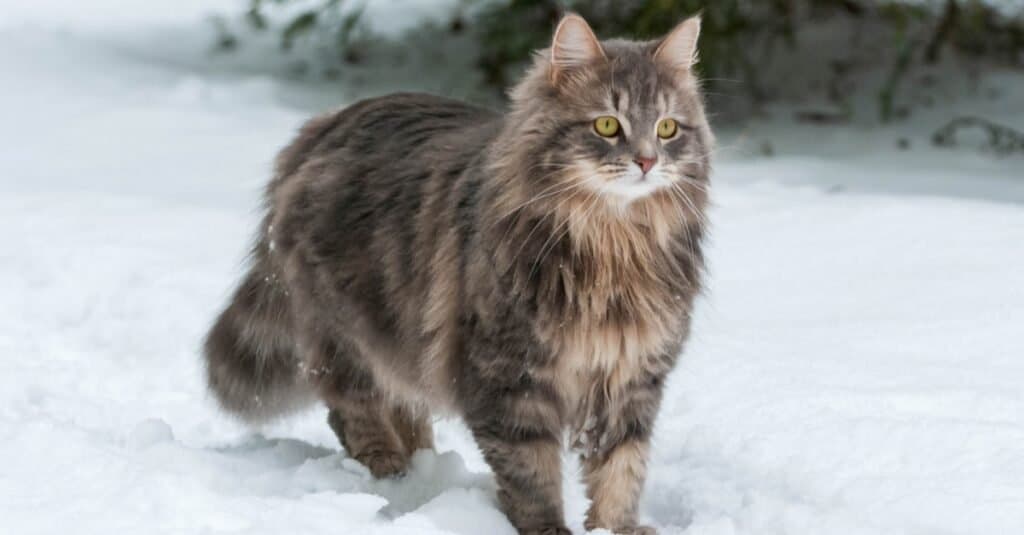
Strong, powerful bodies also characterize Siberian cats.
©Emil Helge/Shutterstock.com
BLUE SMOKE: This is one of the most stunning Siberian cats. It has a white undercoat with blue tips. When the cat is still, the blue is visible; however, white is more prominent when it moves. Its tail, face, and legs feature a light blue hue, with a thin strip of white near the skin. It also has white neck fur and tufts around its ears. Lastly, its nose leather and paw pads should ideally be blue.
CAMEO SMOKE: This type of Siberian cat is also referred to as the Red Smoke. Their coat is white at the base but heavily shaded with red. When standing still, the cat appears red, but when in motion, the white undercoat stands out. The tail, legs, and face are all red in color, with a thin strip of white near the skin. The neck fringe and ear tufts are white, and a desirable shade of rose is present on the nose, toe pads, and around the eyes.
CREAM SMOKE: This type of Siberian cat has a white undercoat and a cream-colored topcoat. The cream color is more prominent when the cat is still, but the white undercoat is apparent when the cat moves. The tail, legs, and face have a cream-colored topcoat with a thin white band near the skin, which you can’t see unless you part their hair to peer beneath. Additionally, the cat has white ear hair tufts and white neck fur, and its nose and bottoms of its feet are pink.
SMOKE TORTOISESHELL: This Siberian cat has a unique type of coat, consisting of a white undercoat with dark tips and patches of red and cream in the pattern of a tortoiseshell cat. When the cat sleeps, it looks like a tortoiseshell, but the white undercoat is more visible when it moves. It also has a white collar around its neck and ear hairs, with patches of red or cream on its face.
BLUE-CREAM SMOKE: Siberian cats come in many different colors and patterns, including a stunning blue-cream variety. The main color of this type of cat is blueish-white, with a white sheen that becomes more distinct when the cat is in motion. Cream patches are also visible on the tail, legs, and face. A white neck scruff and tufts on the ears are also present, with a desirable flare of cream shading on the face.
CLASSIC TABBY: These types of Siberian cats have dense, well-defined, and wide markings on their legs that look like bracelets. They also have rings on their tail and necklaces on their neck and upper chest. The “M” shape frown marks on their forehead form an elaborate design, while vertical lines over the back of their head extend to the shoulder markings in the shape of a butterfly. On their back, three stripes run down the spine, and a large solid blotch on each side is encircled by one or more unbroken rings. Some of these types have white lockets or button patterns in their fur.
PATCHED TABBY: A patched tabby is also called a torbie. It is a type of Siberian cat that comes in brown, blue, silver, or a mixture. They sometimes have patches of cream or red, and they occasionally have lockets or button patterns woven into their fur.
MACKEREL TABBY: These beautiful Siberian cats have thick, distinctly-defined markings on their bodies, consisting of thin stripes and lines. Their legs have thin stripes that go up to meet the body markings. The tail is striped, and they have collars near their chest and neck. The head has an “M” shape on the forehead, and the eyes have unbroken lines running backward from them. The head also has lines running down to the shoulders. The spine lines come together to form a thin bridle on the back, and the body has thin stripes running around it.
SPOTTED TABBY: These gorgeous Siberian cats have distinctive markings on their bodies, typically dots. The spots can range in size and shape but do not run together. The cat’s back has a stripe with spots and tabby markings on the face and forehead. White spots may be present on the underside of the body, while the legs and tail have a barred pattern.
BROWN PATCHED TABBY: The coats of these types of Siberian cats have a brilliant bronze or golden brown hue with the traditional tabby patterns of dark black and patches of cream and red visible on the body and limbs. A burst of cream or red or both is hoped for around the face, with the eye-rings, chin, and lips all matching in color.
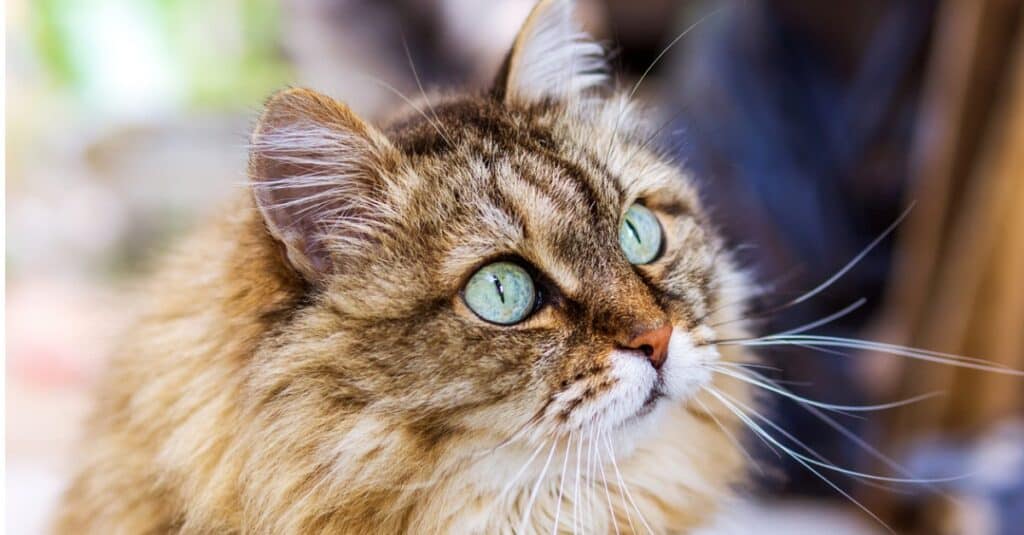
There are an astonishing variety of Siberian cat coats and colors.
©iStock.com/Алексей Филатов
TICKED TABBY PATTERN: Their fur is composed of thick, speckled hairs, and the colors can vary. From the top view, the coat should not have any spots, stripes, or blotches except for a darker shade along the back. The underside may have tabby markings, and the tail, legs, and face should have distinguishable stripes. Some of these types of Siberian cats have white spots.
BLUE-PATCHED TABBY: This Siberian cat has a light ivory base color that looks blueish-cream from a distance. They are known for their dark blue stripes, known as classic or mackerel tabby markings. Cream patches should be visible on the body and limbs, and a burst of off-white on the face is favored. Some Siberian cats of this type have a sheen of overall fawn color.
SILVER PATCHED TABBY: This cat has a base color of light sparkling silver with the darkest black patches mixed with cream and red on the body and legs. The chin and lips are also a silvery white color, and a bright burst of red or off-white on the face is a stunning and desirable trait.
SILVER TABBY: This Siberian cat has a bright silver base color with black markings. The silver sheen continues to the chin and lips. The markings can be either mackerel, flecked, spotted, or classic tabby. The nose is dark red, and the toe pads are dark black.
BLUE-SILVER TABBY: This lovely cat has a deep silver coat and markings of the deepest blue. The contrast has a stunning effect! The lips and chin are sometimes rimmed in white, the nose is pink, and the toe pads are also pink. The blue markings can be either mackerel, classic tabby, flecks, or spots. All are equally beautiful.
BLUE-SILVER PATCHED TABBY: This Siberian cat comes with a base color of silver with dark blue markings in a mackerel or classic tabby pattern. The body and legs have patches of cream, and a bright patch of cream around the face is lovely. The shin and lips can be any color, including white.
RED TABBY: This is a red Siberian cat! The markings are an even deeper red and can appear as spots, flecks, mackerel tabby, or classic tabby patterns. The toe pads, nose, chin, and lips are all red. What a beautiful cat!
BROWN TABBY: This lovely Siberian cat is a shiny copper color. The backs of their legs are dark black, and they have black markings in either tabby, stripes, spots, or flecks. Their toe pads and noses are either brown or black.
BLUE TABBY: Blue ivory is the name of the game for this Siberian cat. The base color is blueish-silver, and the over-pattern is dark blue. The patterns can appear in mackerel tabby, spots, flecks, or classic tabby shapes. The underside of the feet and nose are both pink. Some of these cats have an overall sheen of tawny or fawn from a distance.
CREAM TABBY: From a distance, this cat appears almost entirely a muted cream color. Upon closer inspection, you will see many shades of cream, white, and fawn mixed together in a fleck, dotted, or tabby pattern. Even the chin, ear tufts, and chin are cream-colored. The underside of the feet and nose are both pink.
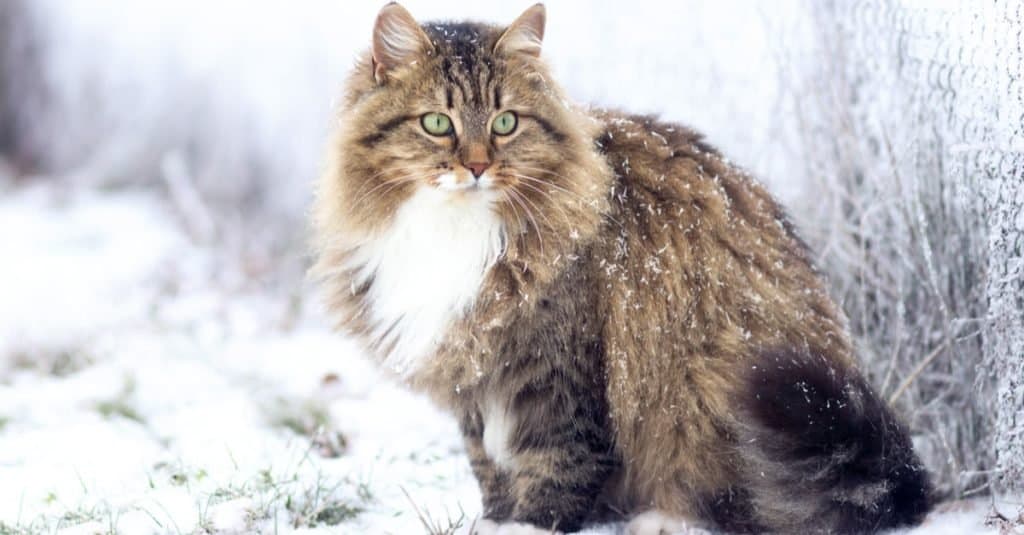
The Siberian is a strong and powerfully built cat with strong hindquarters, large, well-rounded paws, and an equally large full tail.
©fantom_rd/Shutterstock.com
CREAM SILVER TABBY: This is another Siberia cat that looks entirely cream-colored from afar. When you look more closely, you will see a white undercoat, cream color markings that can appear as spots, dots, flecks, or stripes, and a beautiful pink nose.
CAMEO TABBY: This Siberian cat has a white base coat close to the skin and markings in bright red. The underside of the feet and nose is pink. The red markings can be spots, dots, flecks, or stripes.
BLUE GOLDEN TABBY: This is one of the most unusual Siberian cats to spot. The contrast in colors is definitely eye-catching. The overall color of the coat is gold, apricot, or hone colored, but the over-markings are dark blue! The dark blue markings can be dots, spots, flecks, classic tabby, or mackerel tabby patterns. The underside of the feet can be either pink or blue, and the nose is always pink.
GOLDEN TABBY: This Siberian cat has two totally different colors in contrast to each other. The base color of the fur is orange, apricot, honey, or gold. The contrasting markings are the darkest black and can appear as spots, dots, flecks, or tabby patterns. The undersides of the feet are always black, and the nose is always pink.
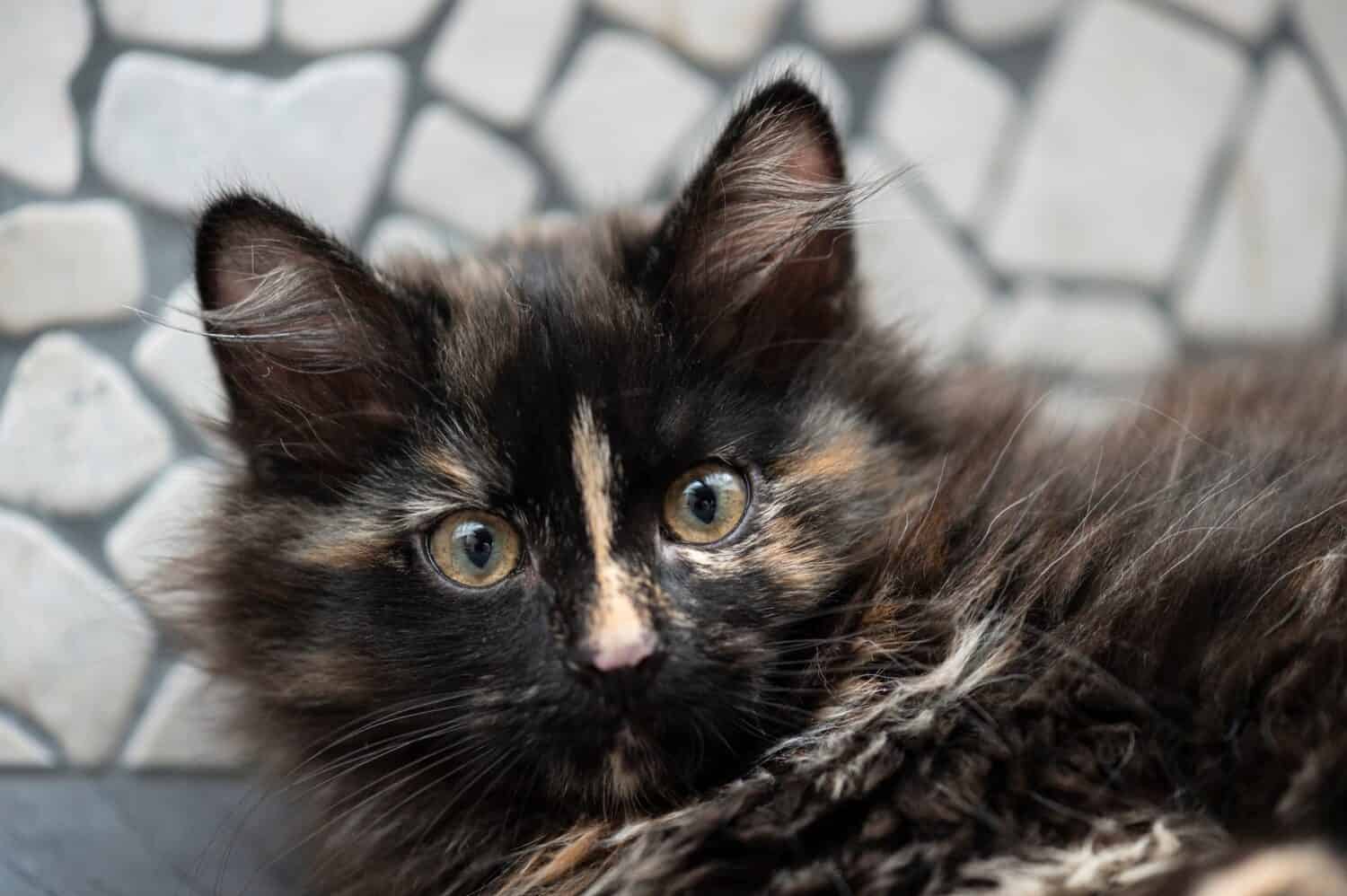
Tortoiseshell is just one of the types of Siberian cat colorings.
©Heidi Bollich/Shutterstock.com
TORTOISESHELL: This Siberian cat is either a mix of red with red or black with red for a lovely tortoiseshell pattern. The contrast is softly mixed and mingled together rather than starkly defined stripes.
CALICO: These beautiful Siberian cats are red and black with a white undercoat. The lower parts of the cat (belly, lets, feet) are all pure white. Some of them have a triangular patch on their face that is quite lovely.
DILUTE CALICO: Diluted calicos are cream and blue with a white undercoat. They have white undersides, which include their lower chin, chest, belly, legs, and feet. Some of them are lucky enough to have a beautiful triangular pattern o their faces.
BLUE-CREAM: This is a gorgeous blue cat! The overall coloring is blue, with off-white, white, or cream patches covering the entire body, including feet and legs.
BI-COLOR: Bicolored Siberians can come in a wide mixture of colors. Some are smokey gray and white. Some are many different shades of white, and some are tabby with white markings.
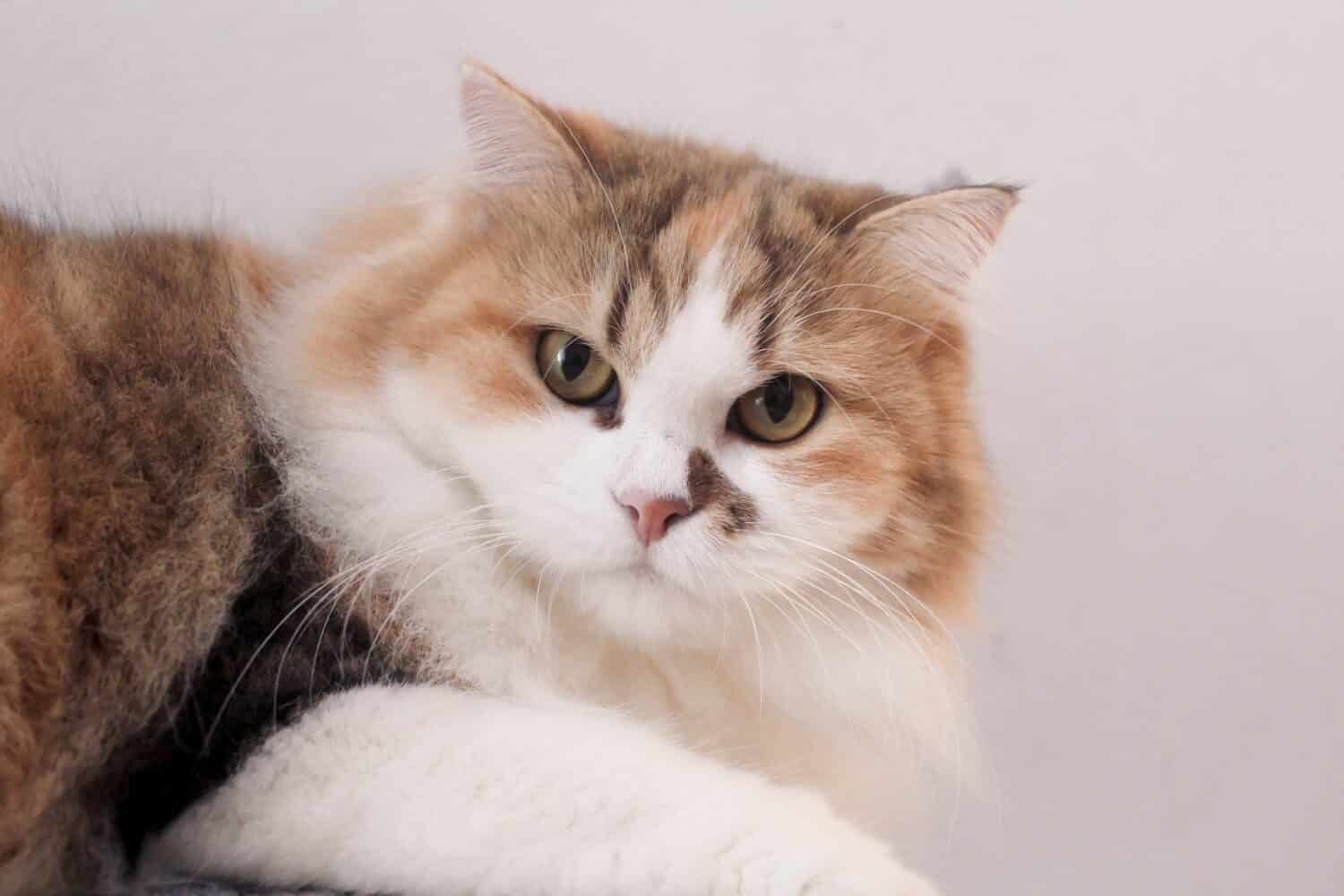
A Calico Siberian cat coloring is a beautiful combination.
©pthiofanni/Shutterstock.com
VAN CALICO: This is a multi-colored Siberian cat with a white undercoat and cream and blue patches on its legs, tail, and head. There are not patches of color on the body very often, but occasionally you will see a few small ones.
COLOR POINTS: There are a wide variety of color-point Siberian Cats. They all have pale-colored bodies and legs that are darker colors. The pointing for Siberians usually consists of a face mask, tail, feet, legs, and ears, a darker color than the body. The “point” colors can be blue, seal brown, red, beige brown, and various colors of cream and beige.
Thank you for reading! Have some feedback for us? Contact the AZ Animals editorial team.







